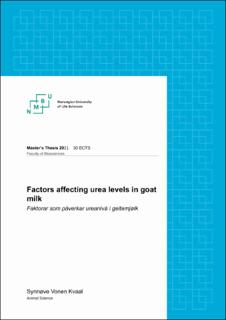| dc.description.abstract | The optimal milk urea level for Norwegian dairy goats is not known, and further study on the area is required if to be used as an indicator of efficiency in nitrogen metabolism. The aim of this study was to examine factors affecting milk urea levels in dairy goat production. Another aim was to investigate the suitability of fourier-transform infrared spectroscopy (FTIR) for analysis of milk urea levels in goats. Data from two experiments, named G110 and D174, were analysed. In G110, 48 multiparous goats of the Norwegian dairy goat breed were assigned to six different isonitrogenous concentrate types with different types and levels of lipid supplements. Measurements of milk urea was taken throughout lactation, including both indoor feeding and mountain grazing period. In D174, 9 rumen fistulated goats of the Norwegian dairy goat breed were assigned to three different isonitrogenous concentrate types. The experiment was performed as a 3x3 Latin square with three replicates, where the daily concentrate level was gradually increased from 1.5 to 2.55 kg dry matter (DM). In G110, a significant effect of lactation stage on milk urea levels was found, while parity showed no effect on milk urea levels. A significant negative correlation between milk yield and milk urea levels was found at 185 and 225 days in milk. A significant negative correlation between milk urea levels and milk protein percentage was found at 55 and 85 days in milk. In early and late lactation of D174, milk urea levels were significant positively correlated to the level of dietary crude protein (CP), protein balance in the rumen (PBV), and amino acids absorbed in the small intestine per feed unit milk (AAT/FEm). A discrepancy between milk urea levels analysed by FTIR and milk urea levels analysed by chemical methods was observed in both experiments. In conclusion, milk urea levels vary according to several factors related to both dietary factors and physiological status. In order to utilize FTIR for analysis of milk urea levels in Norwegian dairy goats, a better calibration of the FTIR-instrument is necessary. The results suggest that milk urea levels have a potential to be used as an indicator of efficiency in nitrogen metabolism of Norwegian dairy goats. | en_US |

